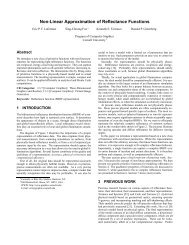pigmented colorants: dependence on media and time - Cornell ...
pigmented colorants: dependence on media and time - Cornell ...
pigmented colorants: dependence on media and time - Cornell ...
You also want an ePaper? Increase the reach of your titles
YUMPU automatically turns print PDFs into web optimized ePapers that Google loves.
This routinely happens when you view an object under different lighting c<strong>on</strong>diti<strong>on</strong>s.<br />
For instance, the spectral distributi<strong>on</strong> of indoor tungsten lights is different to that<br />
of natural sunlight. Yet, a sheet of notebook paper in each is still perceived as<br />
white. The tendency of an object’s color to remain unchanged despite changes<br />
in the light spectrum is called color c<strong>on</strong>stancy. To achieve color c<strong>on</strong>stancy, the<br />
visual system must separate the surface’s reflecti<strong>on</strong> properties from the spectral<br />
distributi<strong>on</strong> of the emitted light. One way this is d<strong>on</strong>e is the visual system adjusts<br />
its sensitivity to the overall level of illuminati<strong>on</strong>, called light adaptati<strong>on</strong>. One<br />
has experienced this by entering a very dark room, such as a movie theater–the<br />
eyes gradually adjust to much lower light levels after a few minutes. Colored<br />
afterimages, which are often experienced after l<strong>on</strong>g exposures to the same stimulus,<br />
are attributed as an effect of adaptati<strong>on</strong>. In this case, different regi<strong>on</strong>s of the eye<br />
have adapted to different colors, not an overall luminance change.<br />
Yet, adaptati<strong>on</strong> is not a complete explanati<strong>on</strong> for color c<strong>on</strong>stancy. Color c<strong>on</strong>-<br />
trast am<strong>on</strong>g objects <strong>and</strong> their surroundings is also important. Since c<strong>on</strong>trast does<br />
not change much when the illuminati<strong>on</strong> changes, the visual system exploits the<br />
ratios between colors in a scene. This is evident in the work of Edwin L<strong>and</strong> in<br />
his Retinex Theory of Color Visi<strong>on</strong> [Lan77]. In L<strong>and</strong>’s experiment, he created<br />
a painting with a collecti<strong>on</strong> of rectangular shapes of varying hues in the manner<br />
of M<strong>on</strong>drian, a famous abstract painter. For each of five trials, he illuminated a<br />
different colored shape such that it exhibited an identical energy flux to the other<br />
four colors. Hence, all of the energy reaching the viewer’s eye from the five shapes<br />
is identical. The viewer then matched each shape’s color with the closest Munsell<br />
color chip, illuminated under the same source. Even though the five samples all<br />
sent the same physical color sensati<strong>on</strong> to the eye, the viewer had different color<br />
91



